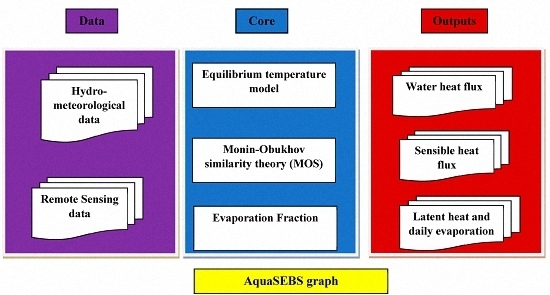Surface Energy Balance of Fresh and Saline Waters: AquaSEBS
Abstract
:1. Introduction
- Adapting the parameterizations of the water heat flux (identical to ground heat flux in terrestrial surface energy calculations) and the heat and momentum roughnesses in a selected surface energy balance model;
- Upscaling the calculated evaporation rate from instantaneous to daily;
- Applying a salinity correction factor in the calculation.
2. Methods
2.1. Description of the SEBS Model
2.1.1. Heat Flux (G0)
2.1.2. Sensible Heat Flux (H)
2.1.3. Latent Heat (λE)
2.2. Development of AquaSEBS
- Adapting the formulations of the water heat flux (G0w).
- Identifying the roughness of momentum transfer (z0m) for fresh water.
- Identifying the roughness of heat transfer (z0h) for fresh waters.
- Modifying the parameterization of the evaporative fraction to upscale the instantaneous values to daily values.
- Adding a salinity-correction term to the latent heat of vaporization.
2.2.1. Water Heat Flux (G0w)
2.2.2. The Roughness Height for Momentum Transfer (z0m)
2.2.3. The Roughness Height for Heat Transfer (z0h)
2.2.4. Up-Scaling to Daily Values
2.2.5. Correction for Salinity
3. Data Collection and Analysis
3.1. Processing the IJsselmeer Data
3.2. Analysis
4. Results and Discussions
4.1. Water Heat Flux
4.2. Momentum and Heat Transfer Roughness Heights
4.3. Daily Evaporation
4.4. Evaluation of AquaSEBS over Fresh Water
4.5. Salinity Effect
4.6. Evaluation and Sensitivity Analysis
5. Conclusions
Acknowledgments
Author Contributions
Conflicts of Interest
References
- Williams, P.D.; Guilyardi, E.; Madec, G.; Gualdi, S.; Scoccimarro, E. The role of mean ocean salinity in climate. Dyn. Atmos. Oceans 2010, 49, 108–123. [Google Scholar] [CrossRef]
- Shoko, C.; Clark, D.J.; Mengistu, M.G.; Bulcock, H.; Dube, T. Estimating spatial variations of total evaporation using multispectral sensors within the uMngeni catchment, South Africa. Geocarto Int. 2016, 31, 256–277. [Google Scholar] [CrossRef]
- Su, Z. The Surface Energy Balance System (SEBS) for estimation of turbulent heat fluxes. Hydrol. Earth Syst. Sci. 2002, 6, 85–99. [Google Scholar] [CrossRef]
- Jia, L.; Su, Z.; van den Hurk, B.; Menenti, M.; Moene, A.; De Bruin, H.A.; Yrisarry, J.J.B.; Ibanez, M.; Cuesta, A. Estimation of sensible heat flux using the Surface Energy Balance System (SEBS) and ATSR measurements. Phys. Chem. Earth Parts A/B/C 2003, 28, 75–88. [Google Scholar] [CrossRef]
- Rwasoka, D.T.; Reyes-Acosta, J.L.; van der Tol, S.C.Z.; Lubczynski, M.W. Evapotranspiration in water limited environments: Up-scaling from the crown canopy to the eddy flux footprint + poster. In Proceedings of the EGU General Assembly, Vienna, Austria, 2–7 May 2010.
- Su, Z.; Pelgrum, H.; Menenti, M. Aggregation effects of surface heterogeneity in land surface processes. Hydrol. Earth Syst. Sci. 1999, 3, 549–563. [Google Scholar] [CrossRef]
- Rwasoka, D.T.; Gumindoga, W.; Gwenzi, J. Estimation of actual evapotranspiration using the Surface Energy Balance System (SEBS) algorithm in the Upper Manyame catchment in Zimbabwe. Phys.Chem. Earth 2011, 36, 736–746. [Google Scholar] [CrossRef]
- Brutsaert, W. Aspects of bulk atmospheric boundary layer similarity under free-convective conditions. Rev. Geophys. 1999, 37, 439–451. [Google Scholar] [CrossRef]
- Jia, L.; Xi, G.; Liu, S.; Huang, C.; Yan, Y.; Liu, G. Regional estimation of daily to annual regional evapotranspiration with MODIS data in the Yellow River Delta wetland. Hydrol. Earth Syst. Sci. 2009, 13, 1775–1787. [Google Scholar] [CrossRef]
- Liu, S.M.; Lu, L.; Mao, D.; Jia, L. Evaluating parameterizations of aerodynamic resistance to heat transfer using field measurements. Hydrol.Earth Syst. Sci. 2007, 11, 769–783. [Google Scholar] [CrossRef]
- Abreham Kibret, A. Open Water Evaporation Estimation Using Ground Measurements and Satellite Remote Sensing: A Case Study of Lake Tana, Ethiopia; ITC: Enschede, The Netherlands, 2009; p. 97. [Google Scholar]
- Koloskov, G.; Mukhamejanov, K.; Tanton, T.W. Monin-Obukhov length as a cornerstone of the SEBAL calculations of evapotranspiration. J. Hydrol. 2007, 335, 170–179. [Google Scholar] [CrossRef]
- Tian, X.; Li, Z.Y.; van der Tol, C.; Su, Z.; Li, X.; He, Q.S.; Bao, Y.F.; Chen, E.X.; Li, L.H. Estimating zero-plane displacement height and aerodynamic roughness length using synthesis of LiDAR and SPOT-5 data. Remote Sens. Environ. 2011, 115, 2330–2341. [Google Scholar] [CrossRef]
- Xiong, J.; Wu, B.F.; Yan, N.N.; Zeng, Y.A.; Liu, S.F. Estimation and Validation of Land Surface Evaporation Using Remote Sensing and Meteorological Data in North China. IEEE J. Sel. Top. Appl. Earth Obs. Remote Sens. 2010, 3, 337–344. [Google Scholar] [CrossRef]
- Elhag, M.; Psilovikos, A.; Manakos, I.; Perakis, K. Application of the SEBS Water Balance Model in Estimating Daily Evapotranspiration and Evaporative Fraction from Remote Sensing Data over the Nile Delta. Water Resour. Manag. 2011, 25, 2731–2742. [Google Scholar] [CrossRef]
- Abualnaja, Y. Estimation of the Net Surface Heat Flux in the Arabian Gulf Based on the Equilibrium Temperature. J. King Abdulaziz Univ. 2009, 20, 21–29. [Google Scholar] [CrossRef]
- Edinger, J.E.; Duttweiler, D.W.; Geyer, J.C. The Response of Water Temperatures to Meteorological Conditions. Water Resour. Res. 1968, 4, 1137–1143. [Google Scholar] [CrossRef]
- Ahmad, F.; Sar, S. Equilibrium temperature as a parameter for estimating the net heat-flux at the air-sea interface in the central red-sea. Oceanol. Acta 1994, 17, 341–343. [Google Scholar]
- Zhou, Y.L.; Ju, W.; Sun, X.; Wen, X.; Guan, D. Significant decrease of uncertainties in sensible heat flux simulation using temporally variable aerodynamic roughness in two typical forest ecosystems of China. J. Appl. Meteorol. Climatol. 2012, 51, 1099–1110. [Google Scholar] [CrossRef]
- Blümel, K. A simple formula for estimation of the roughness length for heat transfer over partly vegetated surfaces. J. Appl. Meteorol. 1999, 38, 814–829. [Google Scholar] [CrossRef]
- Yang, R.; Friedl, M.A. Determination of roughness lengths for heat and momentum over boreal forests. Bound.-Layer Meteorol. 2003, 107, 581–603. [Google Scholar] [CrossRef]
- Tanny, J.; Cohen, S.; Assouline, S.; Lange, F.; Grava, A.; Berger, D.; Teltch, B.; Parlange, M.B. Evaporation from a small water reservoir: Direct measurements and estimates. J. Hydrol. 2008, 351, 218–229. [Google Scholar] [CrossRef]
- Brutsaert, W.H. Evaporation into the Atmosphere—Theory, History, and Applications; Springer: Dordrecht, The Netherlands, 1982; p. 297. [Google Scholar]
- Su, Z.; Schmugge, T.; Kustas, W.P.; Massman, W.J. Evaluation of two models for estimation of the roughness height for heat transfer between the land surface and the atmosphere. J. Appl. Meteorol. 2001, 40, 1933–1951. [Google Scholar] [CrossRef]
- Cahill, A.T.; Parlange, M.B.; Albertson, J.D. On the Brutsaert temperature roughness length model for sensible heat flux estimation. Water Resour. Res. 1997, 33, 2315–2324. [Google Scholar] [CrossRef]
- Leaney, F.; Christen, E. Evaluating Basin Leakage Rate, Disposal Capacity and Plume Development; CRC for Catchment Hydrology: Monash, Vic, Australia, 2000. [Google Scholar]
- Turk, L.J. Evaporation of Brine: A field study on the Bonneville Salt Flats, Utah. Water Resour. Res. 1970, 6, 1209–1215. [Google Scholar] [CrossRef]
- Van der Tol, C.; University of Twente, Enschede, The Netherlands. Personal communication, 2012.
- Kljun, N.; Calanca, P.; Rotach, M.; Schmid, H. A simple parameterisation for flux footprint predictions. Bound.-Layer Meteorol. 2004, 112, 503–523. [Google Scholar] [CrossRef]
- Salama, M.S.; Velde, R.; Van der Woerd, H.J.; Kromkamp, J.C.; Philippart, C.J.M.; Joseph, A.T.; O'Neill, P.E.; Lang, R.H.; Gish, T.; Werdell, P.J.; et al. Technical note: Calibration and validation of geophysical observation models. Biogeosciences 2012, 9, 2195–2201. [Google Scholar] [CrossRef] [Green Version]
- Mohammed, I.N. Modeling the Great Salt Lake, Master‘s Thesis, Utah State University, Logan, UT, USA, 2006. [Google Scholar]
- Sollie, S.; Coops, H.; Verhoeven, J.T.A. Natural and constructed littoral zones as nutrient traps in eutrophicated shallow lakes. Hydrobiologia 2008, 605, 219–233. [Google Scholar] [CrossRef]
- Kaddumukasa, M.; Nsubuga, D.; Muyodi, F.J. Occurence of culturable vibrio cholerae from Lake Victoria, and Rift Valley Lakes Albert And George, Uganda. Lakes Reserv. Res. Manag. 2012, 17, 291–299. [Google Scholar] [CrossRef]
- Nuru, A.; Molla, B.; Yimer, E. Occurrence and distribution of bacterial pathogens of fish in the southern gulf of Lake Tana, Bahir Dar, Ethiopia. Livest. Res. Rural Dev. 2012, 2, 2–4. [Google Scholar]
- Manrique Suñén, A.; Nordbo, A.; Balsamo, G.; Beljaars, A.; Mammarella, I. Land surface model over forest and lake surfaces in a boreal site-evaluation of the tiling method. In Proceedings of the European Geosciences Union General Assembly EGU, Vienna, Austria, 22–27 April 2012.
- Salhotra, A.M.; Adams, E.E.; Harleman, D.R.F. The alpha, beta, gamma of evaporation from saline water bodies. Water Resour. Res. 1987, 23, 1769–1774. [Google Scholar] [CrossRef]
- Burba, G.G.; Verma, S.B.; Kim, J. Energy fluxes of an open water area in a mid-latitude prairie wetland. Bound.-Layer Meteorol. 1999, 91, 495–504. [Google Scholar] [CrossRef]
- Meehl, G.A. A Calculation of ocean heat storage and effective ocean surface layer depths for the northern hemisphere. J. Phys. Oceanogr. 1984, 14, 1747–1761. [Google Scholar] [CrossRef]
- Panin, N.G.; Nasonov, E.A.; Foken, T.; Lohse, H. On the parameterisation of evaporation and sensible heat exchange for shallow lakes. Theor. Appl. Climatol. 2006, 85, 123–129. [Google Scholar] [CrossRef]

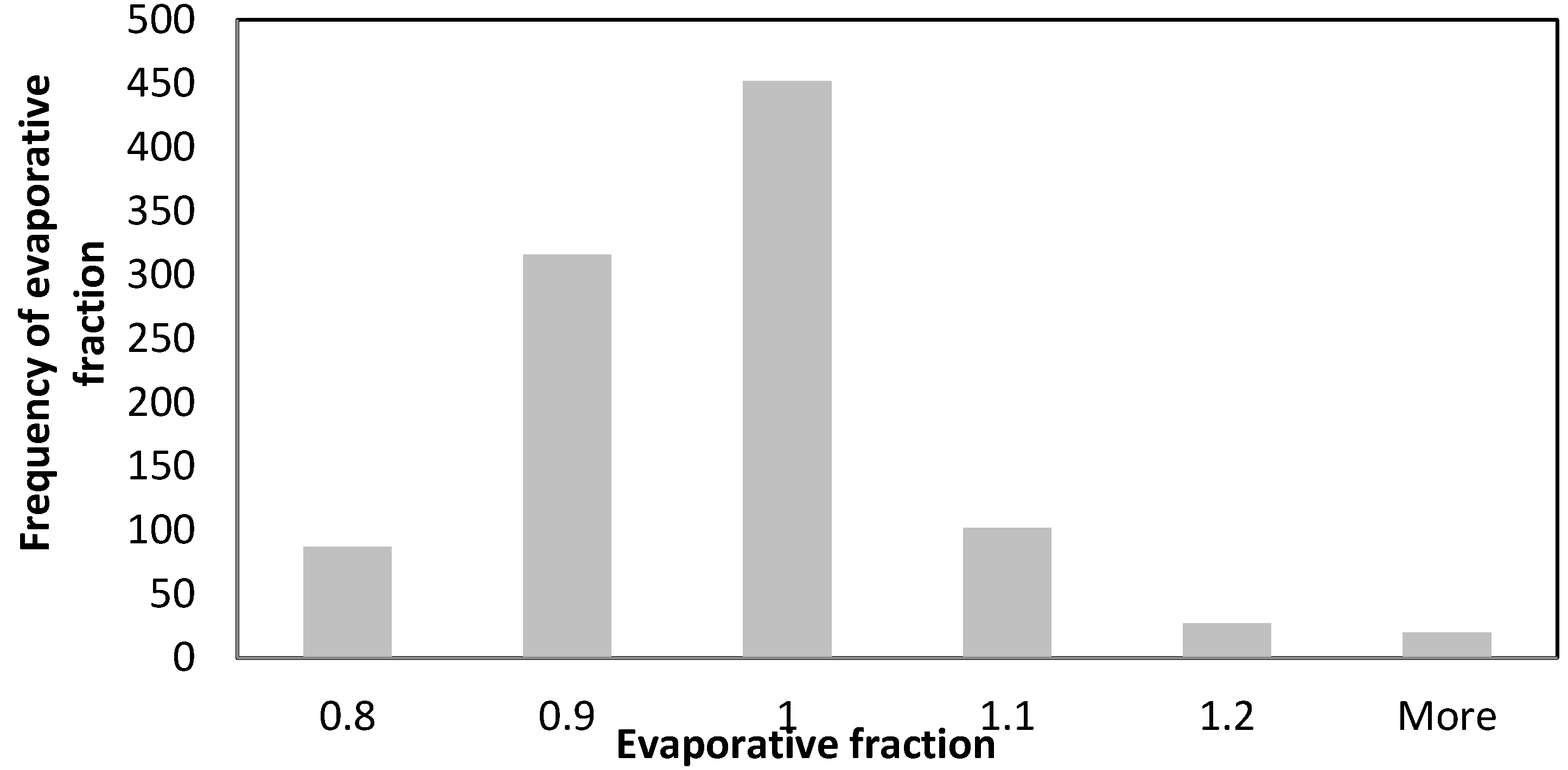
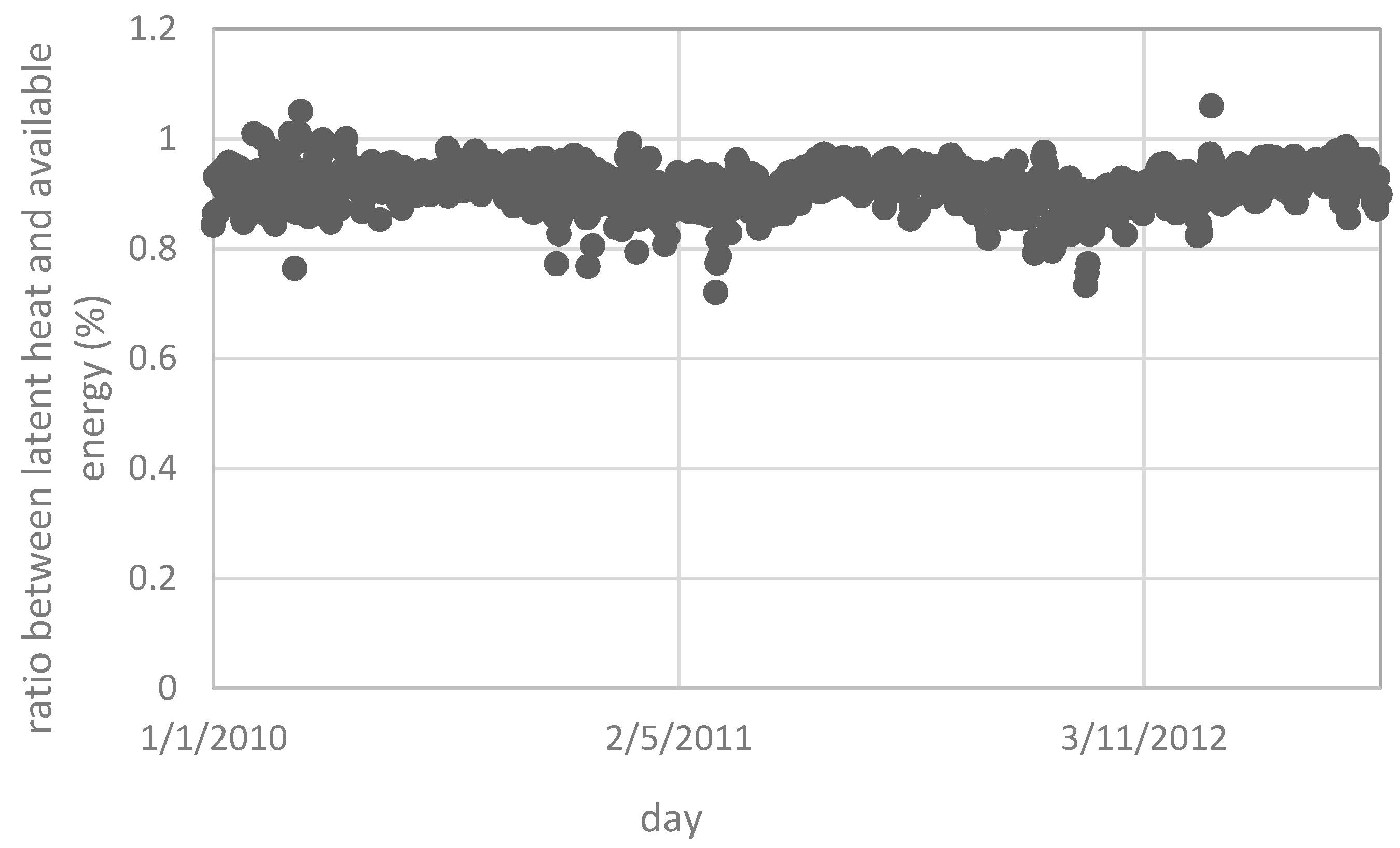

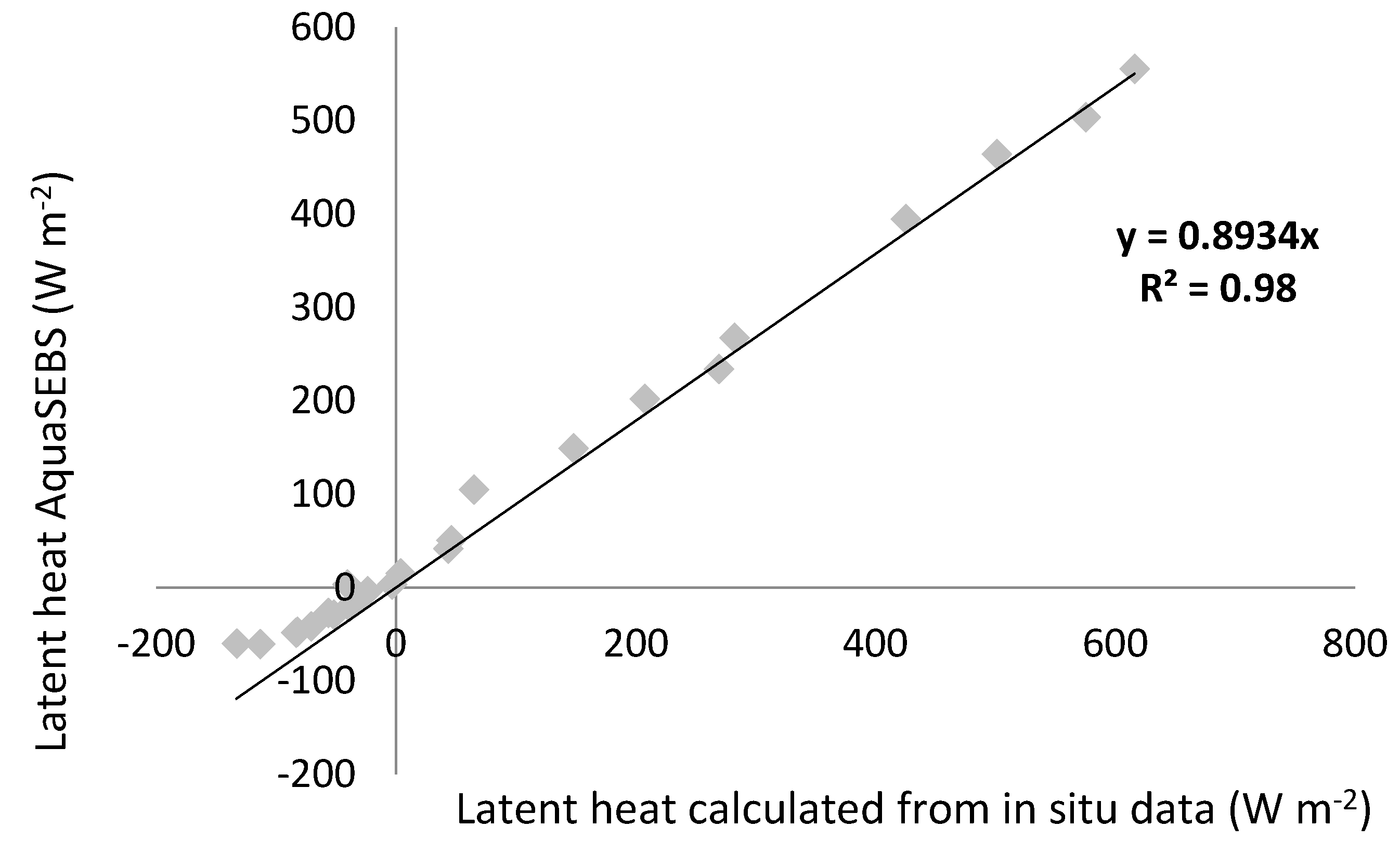
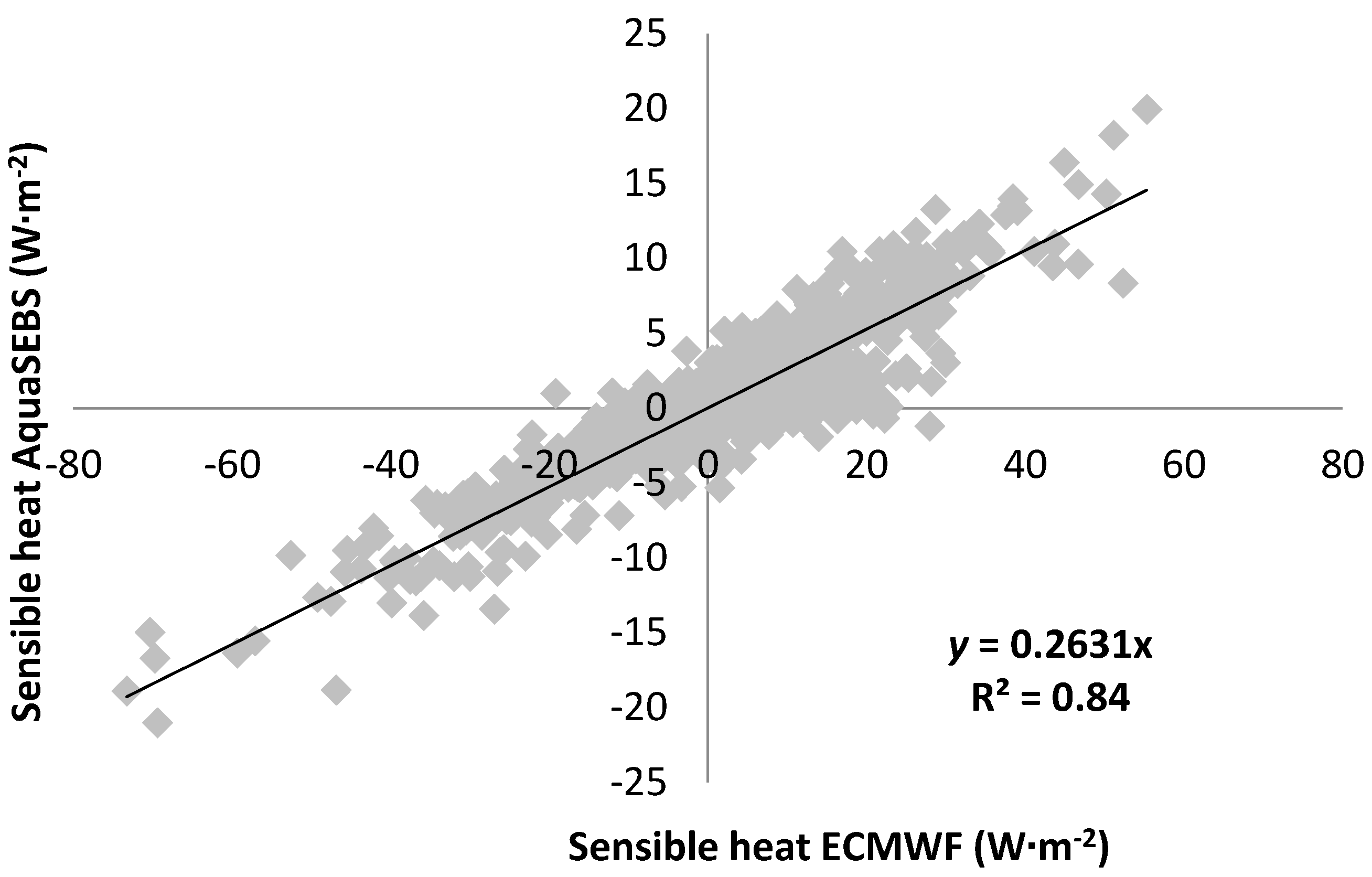
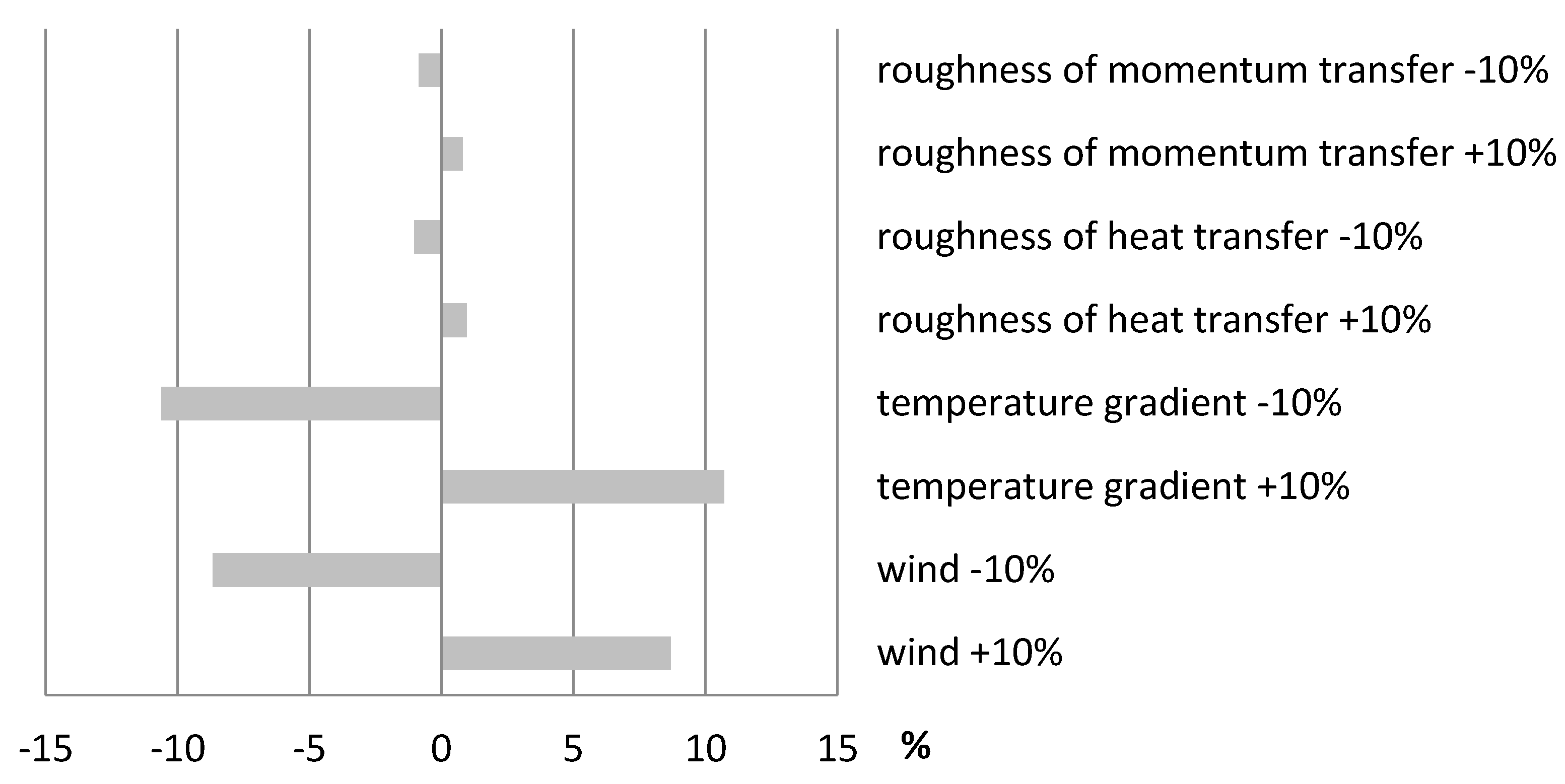
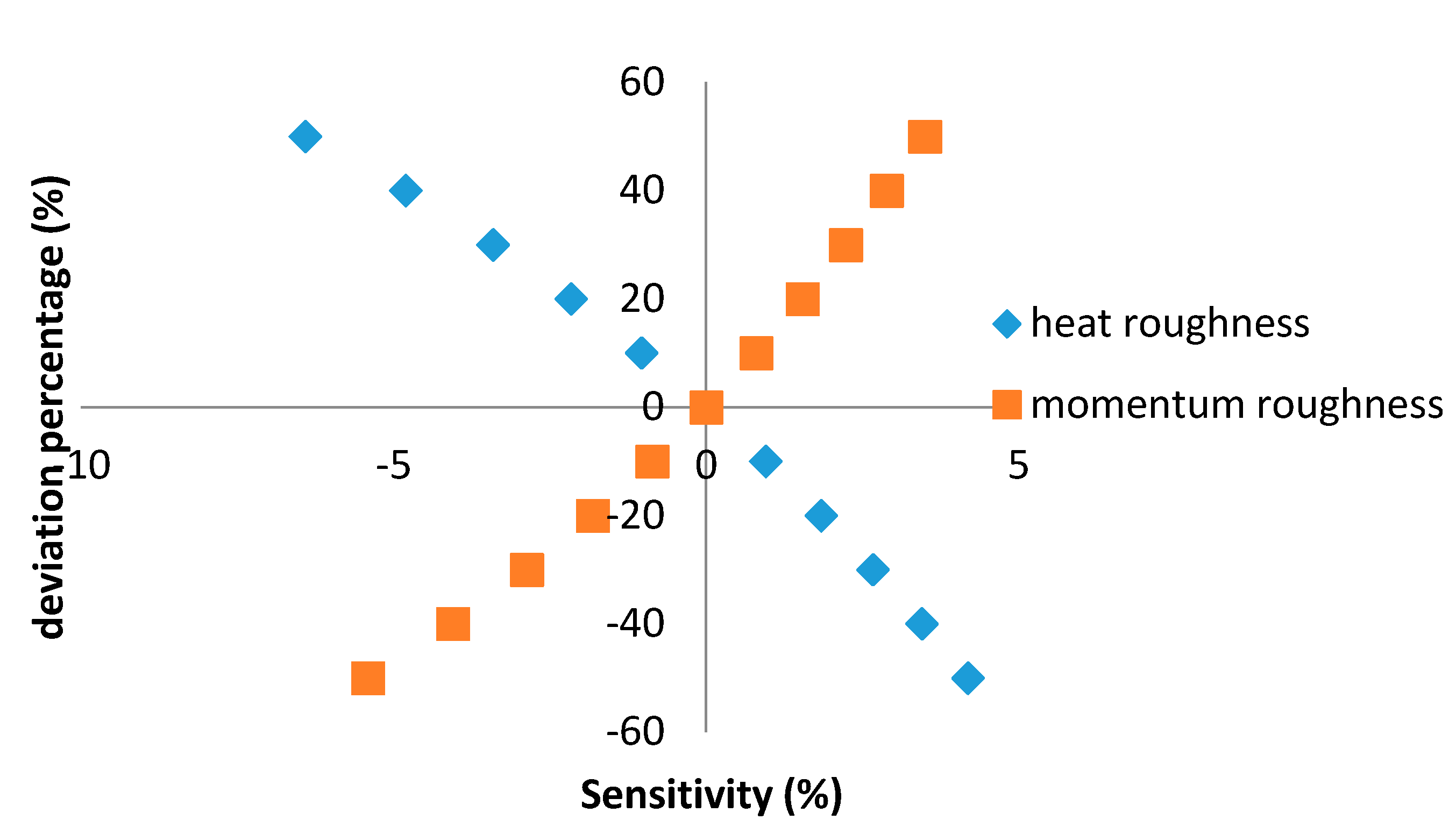
| Study Area | Corners of the Area | Salinity (g·L−1) | Descriptor | |
|---|---|---|---|---|
| Upper Right | Lower Left | |||
| Great Salt Lake | 41°30′00″N | 40°45′00″N | 240 [31] | Brine |
| 111°45′00″W | 112°30′00″W | |||
| Atlantic Ocean | 24°30′00″N | 23°30′00″N | 34.7 [1] | Saline |
| 39°30′00″W | 40°30′00″W | |||
| Indian Ocean | 18°30′00″S | 19°30′00″S | 34.7 [1] | |
| 74°30′00″E | 73°30′00″E | |||
| Mediterranean Sea | 33°30′00″N | 32°30′00″N | 34.7 [1] | |
| 26°30′00″E | 25°30′00″E | |||
| North Sea | 60°30′00″N | 59°30′00″N | 34.7 [1] | |
| 00°30′00″E | 00°30′00″W | |||
| Red Sea | 18°30′00″N | 17°30′00″N | 34.7 [1] | |
| 39°30′00″E | 38°30′00″E | |||
| IJsselmeer lake | 52°49′00″N | 52°49′00″N | 0.6 [32] | Brackish |
| 5°15′00″E | 5°15′00″E | |||
| Lake Victoria | 00°30′00″S | 01°30′00″S | 0.17 [33] | Fresh |
| 33°30′00″E | 32°30′00″E | |||
| Lake Tana | 37°30′00″S | 37°30′00″S | 0.143 [34] | |
| 12°00′00″E | 12°00′00″E | |||
| Area | Indian Ocean | Atlantic Ocean | Mediterranean Sea | North Sea | Red Sea | |||||
|---|---|---|---|---|---|---|---|---|---|---|
| Model | AquaSEBS | ECMWF | AquaSEBS | ECMWF | AquaSEBS | ECMWF | AquaSEBS | ECMWF | AquaSEBS | ECMWF |
| n | 1005 | 1005 | 1005 | 1005 | 1005 | 1005 | 1005 | 1005 | 974 | 974 |
| Average (W·m−2) | 126.5 | 120.0 | 53.7 | 55.7 | 507.5 | 513.8 | 101.1 | 147.7 | 573.3 | 542.7 |
| STD (W·m−2) | 180.5 | 175.1 | 131.6 | 131.8 | 284.8 | 253.8 | 284.2 | 252.5 | 132.5 | 136.3 |
| RMSE (W·m−2) | 32.2 | 26.5 | 49.6 | 68.5 | 42.1 | |||||
| rRMSE (%) | 4.8 | 4.3 | 5.2 | 8.5 | 6.4 | |||||
| LE (AquaSEBS) (W·m−2) | LE (in Situ by [11]) (W·m−2) | H (AquaSEBS) (W·m−2) | H (in Situ by [11]) (W·m−2) | |
|---|---|---|---|---|
| n | 23 | 23 | 23 | 23 |
| Average (W·m−2) | 102.1 | 109.9 | 21.6 | 21.1 |
| STD (W·m−2) | 226.3 | 193.8 | 13.7 | 17.2 |
| RMSE (W·m−2) | 35.6 | 4.8 | ||
| rRMSE % | 10.3 | 7.9 | ||
| Water Heat Flux (W·m−2) | Sensible Heat (W·m−2) | Latent Heat (W·m−2) | Daily Evaporation (mm·day−1) | |||||
|---|---|---|---|---|---|---|---|---|
| AquaSEBS | ECMWF | AquaSEBS | ECMWF | AquaSEBS | ECMWF | AquaSEBS | ECMWF | |
| n | 1005 | 1005 | 1005 | 1005 | 1005 | 1005 | 1005 | 1005 |
| Average (W·m−2) | 110.2 | 110.9 | 3.9 | 4.2 | 51.4 | 51.0 | 4.8 | 4.8 |
| STD (W·m−2) | 82.8 | 79.3 | 4.63 | 5.02 | 34.09 | 29.59 | 2.8 | 1.7 |
| RMSE (W·m−2) | 19.9 | 1.7 | 19.8 | 1.5 | ||||
| rRMSE (%) | 6.7 | 4.1 | 8.9 | 7.4 | ||||
| Atlantic Ocean | Indian Ocean | |||||
|---|---|---|---|---|---|---|
| Aqua SEBS | AquaSEBS (accounting salinity) | ECMWF | Aqua SEBS | AquaSEBS (accounting salinity) | ECMWF | |
| n | 1005 | 1005 | 1005 | 1005 | 1005 | 1005 |
| Average (mm·d−1) | 5.04 | 5.01 | 5.01 | 6.95 | 6.81 | 6.72 |
| STD (mm·d−1) | 1.88 | 1.86 | 1.85 | 2.70 | 2.68 | 2.63 |
| RMSE (mm·d−1) | 0.11 | 0.10 | 0.25 | 0.21 | ||
| rRMSE (%) | 0.90 | 0.81 | 1.44 | 1.27 | ||
| Water Heat Flux (W·m−2) | Sensible Heat (W·m−2) | Latent Heat (W·m−2) | Daily Evaporation (mm·d−1) | |||||
|---|---|---|---|---|---|---|---|---|
| AquaSEBS | ECMWF | AquaSEBS | ECMWF | AquaSEBS | ECMWF | AquaSEBS | ECMWF | |
| n | 1005 | 1005 | 1005 | 1005 | 1005 | 1005 | 1005 | 1005 |
| Average | 110.2 | 110.9 | 3.9 | 4.2 | 51.4 | 51.0 | 4.8 | 4.8 |
| STD | 82.8 | 79.3 | 4.63 | 5.02 | 34.09 | 29.59 | 2.8 | 1.7 |
| RMSE | 19.9 | 1.7 | 19.8 | 1.5 | ||||
| rRMSE (%) | 6.7 | 4.1 | 8.9 | 7.4 | ||||
| Atlantic Ocean | Indian Ocean | Mediterranean Sea | Red Sea | North Sea | ||||||
|---|---|---|---|---|---|---|---|---|---|---|
| AquaSEBS | ECMWF | AquaSEBS | ECMWF | AquaSEBS | ECMWF | AquaSEBS | ECMWF | AquaSEBS | ECMWF | |
| n | 1005 | 1005 | 1005 | 1005 | 1005 | 1005 | 974 | 974 | 1005 | 1005 |
| Average (W·m−2) | 151.1 | 145.1 | 181.7 | 194.6 | 120.9 | 120.5 | 100.8 | 128.6 | 101.1 | 57.1 |
| STD (W·m−2) | 55.9 | 56.7 | 79.7 | 78.5 | 103.8 | 77.7 | 63.0 | 68.7 | 94.3 | 54.1 |
| RMSE (W·m−2) | 26.9 | 33.7 | 51.1 | 37.6 | 77.5 | |||||
| rRMSE (%) | 6.8 | 7.0 | 8.6 | 10.5 | 14.3 | |||||
| Statistical tools | SEBS | AquaSEBS | ECMWF |
|---|---|---|---|
| Average (mm 3 h−1) | 0.78 | 0.57 | 0.26 |
| STD (mm 3 h−1) | 0.51 | 0.37 | 0.20 |
| RMSE (mm 3 h−1) | 0.63 | 0.38 | |
| rRMSE (%) | 23.48 | 19.60 |
© 2016 by the authors; licensee MDPI, Basel, Switzerland. This article is an open access article distributed under the terms and conditions of the Creative Commons Attribution (CC-BY) license (http://creativecommons.org/licenses/by/4.0/).
Share and Cite
Abdelrady, A.; Timmermans, J.; Vekerdy, Z.; Salama, M.S. Surface Energy Balance of Fresh and Saline Waters: AquaSEBS. Remote Sens. 2016, 8, 583. https://doi.org/10.3390/rs8070583
Abdelrady A, Timmermans J, Vekerdy Z, Salama MS. Surface Energy Balance of Fresh and Saline Waters: AquaSEBS. Remote Sensing. 2016; 8(7):583. https://doi.org/10.3390/rs8070583
Chicago/Turabian StyleAbdelrady, Ahmed, Joris Timmermans, Zoltán Vekerdy, and Mhd. Suhyb Salama. 2016. "Surface Energy Balance of Fresh and Saline Waters: AquaSEBS" Remote Sensing 8, no. 7: 583. https://doi.org/10.3390/rs8070583






